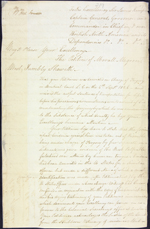Crime and Counterfeits
When we use the word "counterfeit," the first thing we usually think about is forged money. In fact, things like designer clothing, credit cards and software can also be counterfeited. Not only is the act of making counterfeit merchandise illegal, but so is knowingly using or selling those goods. Beware!
Crime
Counterfeiting has been around since the invention of money itself! Even before bills and coins, when people paid in cocoa beans, some sneaky person was making fake beans and passing them off as real.
Why do people counterfeit? There is no simple answer to this question, but greed is definitely one of the main reasons. Counterfeiting money has also been used as a war tactic -- flooding the enemy's market with fake banknotes would bring their economy down to the point where they could no longer afford to make or buy any more weapons.
In Canada, counterfeiting has always had consequences. Between 1821 and 1834, Morrall Magoon, an ill-fated counterfeiter, was arrested, tried and imprisoned three times for passing forged money. The first time Magoon was accused, he spent one year in jail. Immediately after being set free, Magoon was arrested again -- this time for using a fake banknote -- a £15 (British pounds) banknote that had been altered to look like a £1,500 banknote. This was a huge amount of money in those days and Magoon was sentenced to spend time in the pillory -- a wooden structure set up outside, where the head and hands of the guilty were fixed through holes so that they would be ridiculed by passers-by. He also spent two years in prison and had to pay a £500 fine. Only a few months later, in 1825, Magoon was at it again. He was arrested for forging a £10 bill into a £1,000 bill! Amazing what two little zeros can do! This time, Magoon was sentenced to death but instead ended up doing hard labour in captivity. Since there were no prisons in Lower Canada (now Quebec), he was sent to Bermuda to build a naval dockyard and live on a prison ship called the Dromedary. He was released eight years later and it is thought that the only reason he was let go was because he got too sick to work.
Counterfeiting has always been a serious offence. Hundreds of years ago in Canada, counterfeiting was punishable by banishment and even death. Now, making counterfeit money could land you in jail for up to 14 years. Even something as hare-brained as colour-photocopying a bill as a joke could result in a $2,000 fine!
Did you know…?
Secret images are hidden in money to make it harder to counterfeit.
Counterfeits
Like every country, Canada has had its share of counterfeiters. A little over 100 years ago, Detective John Wilson Murray was assigned to a famous case in our history known as the "Million Dollar Counterfeiting." Here's what happened.

John Wilson Murray
Source
One day, in 1875, an expert at the Treasury Department in Washington came across a strange $5 bill. He noticed that it was suspiciously nicer that any other bill he had ever seen! He decided to check its serial number to see if, perhaps, it was counterfeit. He was right -- it was a forgery. And a really good one at that! The discovery of beautiful (but forged) Canadian bills soon followed. Something had to be done quickly and Detective John Wilson Murray, Ontario's first full-time criminal detective, was put on the case of finding the counterfeiters and the plates they were using to print the forged money.
Murray looked in New York, Philadelphia and Washington with no luck. He interviewed many known ex-counterfeiters and showed them the bills. The ex-counterfeiters were impressed. These "masterpieces" could only be the work of a certain Edwin Johnson -- the best engraver in the business. Unfortunately, nobody knew where Johnson was!
Detective Murray searched high and low. Chicago, Indianapolis, Cincinnati, Massachusetts…. Finally, the detective spotted Johnson's son at a Toronto train station. He followed him home and waited to catch Johnson passing a fake bill. This took some time. In 1880, five years after the first forged bill was found, Johnson was arrested for using a fake bill to buy a necktie. When detective Murray arrested him, Johnson didn't make a fuss or deny the charges. Like a true gentleman, he confessed to forgery, led the detective to where the printing plates were buried and even helped to dig them up!
All in all, 21 exceptionally engraved copper plates carefully wrapped in cloth were recovered. These were for seven different counterfeit bills (three plates per bill for the front, the back and even the sides!). One million dollars of counterfeit bills were printed with these plates. The banks and the government were delighted to see the plates finally put out of circulation by Detective Murray. Unfortunately, the forged bills were so good that even after Johnson was caught some of them still circulated as real ones for many, many years!
Look at these two sets of bills. One of them is the handiwork of the "king of counterfeiting," Edwin Johnson, and the other is the real one. See how intricate the engraving is on both bank notes? No wonder his bills fooled the best of the experts for years!
To learn more, visit the Currency Museum website:
www.currencymuseum.ca
Glossary
- banknote: paper money issued by a central bank and used as the country's money
- counterfeit: an imitation of a document or object made to fool people into thinking it's the real thing. It's another word for forgery, most often used to describe forged money. Counterfeiting is a serious crime.
- engraved: cut in a hard surface such as stone or metal








